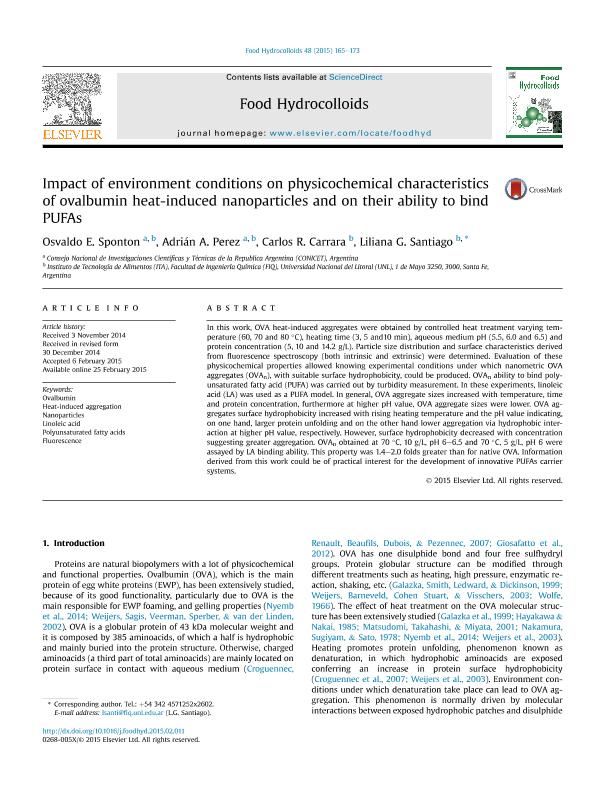Mostrar el registro sencillo del ítem
dc.contributor.author
Sponton, Osvaldo Ernesto

dc.contributor.author
Perez, Adrián Alejandro

dc.contributor.author
Carrara, Carlos R.

dc.contributor.author
Santiago, Liliana G.

dc.date.available
2017-05-19T21:46:46Z
dc.date.issued
2015-06
dc.identifier.citation
Sponton, Osvaldo Ernesto; Perez, Adrián Alejandro; Carrara, Carlos R.; Santiago, Liliana G.; Impact of evironment conditions on physicochemical characteristics of ovalbumin heat-induced nanoparticles and on their ability to bind PUFAs; Elsevier; Food Hydrocolloids; 48; 6-2015; 165-173
dc.identifier.issn
0268-005X
dc.identifier.uri
http://hdl.handle.net/11336/16798
dc.description.abstract
In this work, OVA heat-induced aggregates were obtained by controlled heat treatment varying temperature (60, 70 and 80ºC), heating time (3, 5 and10 min), aqueous medium pH (5.5, 6.0 and 6.5) and protein concentration (5, 10 and 14.2 g/L). Particle size distribution and surface characteristics derived from fluorescence spectroscopy (both intrinsic and extrinsic) were determined. Evaluation of these physicochemical properties allowed knowing experimental conditions under which nanometric OVA aggregates (OVAn), with suitable surface hydrophobicity, could be produced. OVAn ability to bind polyunsaturated fatty acid (PUFA) was carried out by turbidity measurement. In these experiments, linoleic acid (LA) was used as a PUFA model. In general, OVA aggregate sizes increased with temperature, time and protein concentration, furthermore at higher pH value, OVA aggregate sizes were lower. OVA aggregates surface hydrophobicity increased with rising heating temperature and the pH value indicating, on one hand, larger protein unfolding and on the other hand lower aggregation via hydrophobic interaction at higher pH value, respectively. However, surface hydrophobicity decreased with concentration suggesting greater aggregation. OVAn obtained at 70°C, 10 g/L, pH 6-6.5 and 70°C, 5 g/L, pH 6 were assayed by LA binding ability. This property was 1.4-2.0 folds greater than for native OVA. Information derived from this work could be of practical interest for the development of innovative PUFAs carrier systems.
dc.format
application/pdf
dc.language.iso
eng
dc.publisher
Elsevier

dc.rights
info:eu-repo/semantics/openAccess
dc.rights.uri
https://creativecommons.org/licenses/by-nc-nd/2.5/ar/
dc.subject
Ovalbumin
dc.subject
Heat-Induced Aggregation
dc.subject
Nanoparticles
dc.subject
Linoleic Acid
dc.subject
Fluorescence
dc.subject
Polyunsaturated Fatty Acids
dc.subject.classification
Nano-materiales

dc.subject.classification
Nanotecnología

dc.subject.classification
INGENIERÍAS Y TECNOLOGÍAS

dc.title
Impact of evironment conditions on physicochemical characteristics of ovalbumin heat-induced nanoparticles and on their ability to bind PUFAs
dc.type
info:eu-repo/semantics/article
dc.type
info:ar-repo/semantics/artículo
dc.type
info:eu-repo/semantics/publishedVersion
dc.date.updated
2017-05-04T18:44:22Z
dc.journal.volume
48
dc.journal.pagination
165-173
dc.journal.pais
Países Bajos

dc.journal.ciudad
Amsterdam
dc.description.fil
Fil: Sponton, Osvaldo Ernesto. Consejo Nacional de Investigaciones Científicas y Técnicas. Centro Científico Tecnológico Conicet - Santa Fe; Argentina. Universidad Nacional del Litoral. Facultad de Ingeniería Química. Instituto de Tecnología de los Alimentos; Argentina
dc.description.fil
Fil: Perez, Adrián Alejandro. Consejo Nacional de Investigaciones Científicas y Técnicas. Centro Científico Tecnológico Conicet - Santa Fe; Argentina. Universidad Nacional del Litoral. Facultad de Ingeniería Química. Instituto de Tecnología de los Alimentos; Argentina
dc.description.fil
Fil: Carrara, Carlos R.. Universidad Nacional del Litoral. Facultad de Ingeniería Química. Instituto de Tecnología de los Alimentos; Argentina
dc.description.fil
Fil: Santiago, Liliana G.. Universidad Nacional del Litoral. Facultad de Ingeniería Química. Instituto de Tecnología de los Alimentos; Argentina
dc.journal.title
Food Hydrocolloids

dc.relation.alternativeid
info:eu-repo/semantics/altIdentifier/doi/http://dx.doi.org/10.1016/j.foodhyd.2015.02.011
dc.relation.alternativeid
info:eu-repo/semantics/altIdentifier/url/http://www.sciencedirect.com/science/article/pii/S0268005X15000727
Archivos asociados
